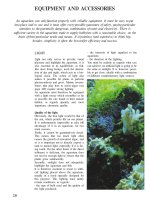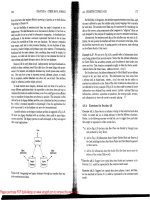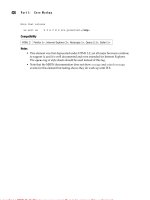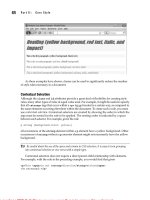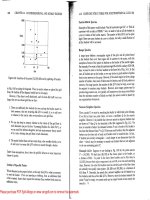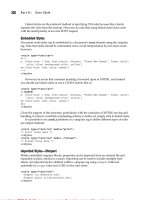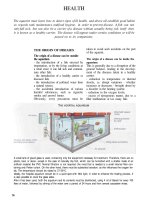The Complete aquarium guide pptx
Bạn đang xem bản rút gọn của tài liệu. Xem và tải ngay bản đầy đủ của tài liệu tại đây (21.2 MB, 288 trang )
A
The Complete
quarium Guide
FISH, PLANTS AND ACCESSORIES FOR YOUR AQUARIUM
© 1995, ATP - Chamalieres - France
All rights reserved. No part of this publication may be reproduced, stored in a retrieval system or transmitted, in any
forms or by any means, electronic, mechanical, photocopying, recording or otherwise, without the prior permission
of the copyright owners.
Original title: Le Grand Guide de I'Aquarium
© 2000 for the English edition:
Konemann Verlagsgesellschaft mbH
Bonner Strasse 126, D - 50968 Cologne
Translation from French: Matthew Clarke and Ian West in association with First Edition Translations Ltd.
Editing: Kay Hyman in association with First Edition Translations Ltd.
Typesetting: The Write Idea in association with First Edition Translations Ltd.
Project Management: Beatrice Hunt for First Edition Translations Ltd., Cambridge, England
Project Coordination: Nadja Bremse-Koob
Production: Ursula Schumer
Printed in Italy by STIGE - Turin
ISBN 3-8290-1736-7
10 987654321CONTENTS
INTRODUCTION 8
WATER: A HAVEN FOR LIFE 10
Fresh water 12
Sea water 24
Different types of aquarium 32
FISH 40
Anatomy and biology 42
Feeding 50
Reproduction 60
Health 66
Nomenclature and distribution of aquarium fish 72
Catalog of freshwater fish 75
Catalog of marine fish 126
INVERTEBRATES 162
Freshwater invertebrates 166
Marine invertebrates 167
Catalog of invertebrates 179
PLANTS 188
Origin and variety of plants 190
Algae problems 193
Caring for plants 196
Catalog of plants 201
TECHNIQUES 216
Assembling a tank 218
Equipment and accessories 226
A balanced aquarium 253
Choosing the bed 260
Decor and background 264
Final preparations 272
CUSTOMIZING YOUR TANK 278
USEFUL INFORMATION 282
INDEX 283
INTRODUCTION
In a dentist's
surgery, a tank of
Amazonian fish
faces the patient's
chair. •
T
here was a time when the keeping
and study of exotic fish was the pre-
serve of serious researchers clos-
eted in their laboratories; today, it is an
established and popular hobby. Dealer-
ships and specialized sales areas in large
stores are springing up everywhere, paral-
leling an explosion in the number of pub-
lic aquariums and books or magazines
devoted to the subject. More and more
people of all ages are falling under the
spell, enjoying permanent access to a part
of the natural world that was formerly
beyond their reach. There are almost as
many kinds of hobbyists as there are types
of fish: the semiprofessional, the "small"
and the "modest" collector, the specialist.
There are the fanatics, who spend every
minute of their time and energy on their
aquariums, while for others fishkeeping is
just a passing fad. Enthusiasts include the
young - and the not so young; those with
scientific knowledge or mere novices;
those actively working and the retired.
Such an immensely varied following guar-
antees that the world of the aquarist is full
of interest and color.
A WINDOW ONTO ANOTHER
WORLD
We have all become familiar with how our
television screens offer us, from the comfort
of our living rooms, a small window onto the
wide world outside. An aquarium also pro-
vides a glimpse into a different universe - but
this time inhabited by real, live creatures.
A lot of thought and work goes into a top-
class aquarium. We select the best site, we
want fish and decor which satisfy our
sense of beauty. Before long, our new
purchase has relegated to the background
our photos, pictures and even the TV.
The last ten or so years have seen the
aquarium come into its own in institutions
and public buildings. In educational estab-
lishments it represents an important teach-
ing aid, enabling students to observe
creatures in conditions resembling their
natural habitats. The medical profession
has likewise realized its benefits. The fish
gliding through their silent, predominantly
green world in a kind of underwater ballet
are the perfect sedative for nervous
patients; it is by no means unusual to
come across tanks in the waiting-rooms of
doctors and dentists, in physiotherapy
rooms, hospitals, and indeed in psychiatric
clinics. More recently, aquariums have
been introduced into prisons.
FISHKEEPING, SCIENCE, AND
AQUACULTURE
Keeping fish contributes to the development
of scientific research into aquatic environ-
ments, and is relevant to the study of animal
and plant biology, ecology, reproduction,
feeding, and behavior. Researchers use
some species to test the toxicity of pollu-
tants or suspected pollutants.
Aquaculture or fish farming - the produc-
tion of living creatures with the principal
aim of selling them as food - has features
in common with fishkeeping. In both
cases, it is a matter of maintaining fish in
captivity and encouraging them to repro-
duce, always under the best possible con-
ditions. The use of aquariums has allowed
us to improve our knowledge of, for
8
example, the breeding of marine larvae
destined eventually for human consump-
tion. It can also aid the preservation of
species threatened with extinction for var-
ious reasons; we can study their behavior
and reproductive methods with the aim of
rearing young which can be released into
their natural habitats.
On the other hand, aquarists are regularly
accused of being party to the destruction
of certain environments.
The fact is that though the vast majority of
freshwater fish kept in aquariums are the
result of captive breeding, the same is not
true of marine fish, which are caught
mainly in their natural habitats. The num-
bers taken are out of all proportion to the
needs of aquarists owing to unsatisfactory
conditions of capture and transport. For
every marine fish which arrives alive in an
aquarium, how many have died as they
were being caught - often in a highly
questionable manner - or during ship-
ment or in the course of acclimatization?
In this sense, the accusation is justified.
The only solution is to impose stricter
controls and improve techniques so that
the number of fish caught to supply
aquarists remains within a safe limit.
A SYSTEM IN EQUIPOISE
The days of goldfish swimming in endless
circles in a glass bowl are long past.
Today, an aquarium is something much
more sophisticated: we are able to recon-
struct Nature in microcosm, which
requires the maintenance of a constant
equilibrium. Nature, if not disturbed by
some cataclysmic imbalance, obeys a
finite set of laws. As aquarists, we need to
understand these laws and reproduce
them on a smaller scale, where the density
of animals and plants is considerably
higher. Everything that takes place within
this mini-universe is under our control -
up to a point. The final, inviolable law is
that conditions in the aquarium must
always approach those found in Nature. If
not, the ecosystem will break down,
spelling disaster.
THE AQUARIUM: AN
ALTERNATIVE APPROACH TO
ECOLOGY
A closed system like this lends itself par-
ticularly to the understanding of ecology,
providing an excellent introduction to a
branch of science which emerged in the
19th century but has acquired a high pro-
file only in the last twenty or so years. It
is not concerned simply with Man and his
world, as many believe, but covers all the
mechanisms regulating relationships
between living creatures and their envi-
ronments, so that all can live in harmony.
• Salmonidae in
Le Bugue
Aquarium. Public
aquariums have
an important role
to play, offering
unrestricted access
to the beauty of
this miniature
world.
9
This type of water is also known as Continental water, a more accurate term from the
scientific point of view. Continental water accounts for only 2.6% of the Earth's water, the
rest being made up of seas and oceans. Of this volume, 98% consists of sterile water, in the
form of glaciers and underground water, leaving only the water of rivers, lakes, and ponds
as shelter for living organisms- barely 2% of the total volume of Continental water.
•
The
use of a
heating kit allows
the water in an
aquarium to be
maintained at an
almost constant
temperature.
TEMPERATURE
An important parameter for aquatic life,
the temperature regulates the growth of
animals and plants and exerts an influence
not only on oxygen levels but also on
many other factors.
Whereas mammals have a regulated and
practically stable internal temperature,
that of fish and other aquarium crea-
tures varies according to the temper-
ature of the water around them. They
can survive only at certain temperatures
and some species are more sensitive than
others to variations in this parameter.
The temperatures of fresh tropical waters,
ranging from 20 to 30°C, are characterized
by less significant variations than those
found in temperate regions. In some
places the shade provided by the tropical
forest cools the water, while in calm water
the temperature goes up under the direct
influence of the sunlight.
The mean temperature most often recom-
mended for aquariums is 25°C, and varia-
tions of 1 or 2° are of little consequence.
Fish are even capable of withstanding
even more significant variations for brief
periods (under 24 hours). On the other
hand, their metabolism (i.e. their general
bodily functioning) is in danger of serious
disturbance over any longer periods, and
sooner or later they may die. It must also
be noted that excessively low tempera-
tures sometimes favor the development of
certain diseases.
OXYGEN AND CARBON
DIOXIDE
Since air contains around 20% oxygen,
even the most oxygenated water rarely
contains more than 1% dissolved oxygen.
Fish have special organs - branchiae -
which allow them to extract most of this
(see Anatomy and Biology, page 42).
Oxygen contributes, in
addition, to the respi-
ration not only of
plants but also of
organisms which are
invisible to the naked
eye and often forgot-
Simple agitation systems
stir the water, enhancing
the diffusion of the oxygen
required by fish. •
12
FRESH WATER
ten: the bacteria. The latter transform the
organic matter emitted from living beings
(excreta and various other residues), and
these chemical reactions similarly require
oxygen.
The oxygen in water comes from the dis-
solution of the oxygen in the air, a process
enhanced by movements in the water pro-
duced by wind, currents, or downward
flow. The more water is stirred, the more
it is oxygenated. Plants also provide oxy-
gen, which they produce through photo-
synthesis, although this process occurs
only by day. The maximum amount of
oxygen that water can contain is deter-
mined by its temperature: the higher this
is, the less oxygen the water can contain
(at 25°C there is 18% less oxygen than at
15°C).
Oxygen is measured in mg/liter, and its
control is quite a complicated matter. The
most turbulent, and therefore the most
oxygenated, water contains 8-10 mg/liter,
while the most deficient water sometimes
has less than 2 mg/liter.
The oxygen content in an aquarium is usu-
ally at its maximum, providing the recom-
mendations for stirring the water are
followed. The rare problems which do
occur are the result of negligence as
regards the overall balance of the aquar-
ium (overpopulation of fish, small number
of plants), or non-functioning of equip-
ment due to forgetfulness, breakdown, or
a power cut.
Carbon dioxide derives from the respira-
tion of fish, plants, and bacteria. Stirring
the water enhances its oxygenation,
thereby reducing the levels of carbon
dioxide in the water, and passing it into
the atmosphere. Carbon dioxide is quite
rare in an aquarium, and this can, to some
extent, prove prejudicial to plants, as they
absorb it by day through photosynthesis to
extract the carbon they need to grow.
It is therefore vital to establish a perma-
nent equilibrium between oxygen, carbon
dioxide, plants, and fish, although this bal-
ance changes at night, when plants stop
producing oxygen.
Carbon dioxide is also one of the main fac-
tors affecting the pH.
PH VALUES
The pH measures the acidity or alkalinity
of water, with the value 7 representing
neutrality. Below this level the water is
acid, and above it the water is alkaline (or
basic). Categorizing water as acid does
not mean that it contains dangerous acids.
In forest streams and rivers the water
accumulates with acid organic fluid
(humic acid) derived from the decomposi-
tion of plants (humus), producing an
amber yellow color.
Generally speaking, aquatic life can exist
only between pH 5 and 9. These extreme
values are rarely found in an aquarium,
where the pH ranges from 6 to 8 accord-
ing to the type of water, and usually lies
between 6.5 and 7.5. In aquariums, the
term acid water corresponds to a pH
between 6 and 6.8, while alkaline water
Maximum oxygen
content of water
as a function of
temperature •
T°C
15
16
17
18
19
20
21
22
23
24
25
26
27
28
mg/lrter
10.1
9.9
9.7
9.5
9.3
9.1
8.9
8.7
8.6
8.4
8.3
8.1
7.9
7.8
13
WATER, A HAVEN FOR LIFE
pH is measured by
using a color test:
water from the
aquarium
containing a few
drops of the test is
compared to a
color scale that
provides a
reasonably precise
determination of
the pH value. T
refers to one between 7.2 and 8, and a pH
between 6.8 and 7.2 is considered neutral.
Variations in pH are mainly the result of
biological activity: the carbon dioxide pro-
duced by living beings acidifies the water
at night and the pH goes down slightly.
Once the carbon dioxide has been
absorbed by the plants during the day the
pH goes up again.
Although slight variations are therefore
normal, more extreme changes can be a
warning signal. The pH is a good indica-
tor of an aquarium's equilibrium, and it
should therefore be measured regularly. A
colored marker dipped into a sample of
water is used to compare the color
obtained with the scale provided. Elec-
tronic meters are also now available for
testing pH values.
Adjusting the pH
The pH of domestic water may not always
be particularly suited to the fish you have
chosen. Furthermore, when an aquarium
is in use the pH can rise and fall, slowly
but very regularly. There are some aquar-
ium products on the market that enable
adjustments to be made to the pH, but
there are other ways of modifying it.
• If the pH is too high
- the water can be diluted with another
more acid water;
- the stirring of the water can be reduced.
Carbon dioxide is eliminated less quickly
and remains in the water to acidify it. Be
careful, because decreasing the stirring
also lowers the oxygenation;
- the water from the aquarium can be fil-
tered over peat, which will release certain
acids. The amount of peat needed to
14
FRESH WATER
maintain a specific pH value must be
found through trial and error, with regular
measurements of the pH.
• If the pH is too low
- the water can be diluted with another
more alkaline, and generally harder water
(see Hardness, below);
- the agitation of the water can be increased,
enhancing the elimination of the carbon
dioxide dissolved in the water and therefore
lifting the pH;
- the water can be filtered over calcareous
material, rock, or oyster shells broken into
little pieces. In this case, the hardness also
increases (see below).
HARDNESS
The hardness of water refers to the com-
bination of substances based on calcium
(Ca) and magnesium (Mg) that are con-
tained in it. The main substances, known
as salts, are carbonates, bicarbonates and
sulfates.
Water with zero hardness does not contain
any of these salts; this is the case with dis-
tilled water.
The water in some areas can be particu-
larly hard, mainly due to the presence of
limestone (or calcium carbonate).
The hardness of water really depends on
the land through which it has passed: the
There are kits on the market that offer
even the novice aquarist the panoply of
tests required to control the majority of
the main parameters for water.
more calcium and magnesium the rocks
contain, the harder the water. The effects
of this can be seen in domestic use: a
washing machine, for example, will
require more detergent. Above certain
limits of hardness (see the table on page
17), water is unfit for human consumption
or any other use. Water with a low degree
of hardness, i.e. containing few calcium
and magnesium salts, is considered soft.
Water with a high degree of hardness is
classified as hard.
FOOD CHAINS
In nature
Life in water, as on land, is not possible without light. Vegetation
(microscopic plankton or plants) absorbs it with carbon dioxide
(CO
2
) and uses the mineral salts, which act as nutrients. This
vegetation serves as food for herbivorous or omnivorous fish, which
in their turn provide nutrition for carnivorous fish. From this point,
the next link in the chain can be aquatic (dolphin, shark), terrestrial
(man), or aerial (bird). When aquatic organisms die, they fall to the
bed. Their bodies are degraded by the action of bacteria, the
material is recycled into mineral salts, and so the chain comes full
circle. (While they are alive, it is their excreta that are recycled.)
15
WATER, A HAVEN FOR LIFE
PEAT
Peat derives from the decomposition of vegetation in an acid
environment lacking in oxygen. This process, which lasts several
centuries, gives rise to a peat bog from which compact, fibrous peat
can be extracted.
It endows water with both a yellow amber color and acidity, which
gives it slightly antiseptic properties. This means that some diseases
are less common in acid water. The use of horticultural peat, which
often has been enriched with various products, must be avoided in
favor of the peat for aquarium use that is commercially available.
Boil it for around 15 minutes before use.
Hemigrammus erythrozonus.
In the Amazon region of South America, the color of the water
ranges from amber yellow to brown, due to the leaves and
branches floating in it. In an aquarium, peat can be used in the
filtering equipment to reproduce the characteristics of this type of
water (low hardness, pH under 7, coloring).
Pterophyllum scalare. T
The hardness of water is expressed in
German degrees (°GH or °DH), not to be
confused with Celsius degrees (°C) for
temperature: 1°GH is equivalent to 17.9
mg Ca/liter, or 17.9 parts per million
(ppm). The term most often used to clas-
sify hardness is general hardness (GH),
although total hardness (TH) can also be
used.
There are three main categories of water
in fishkeeping:
- soft water, which is generally acid, at
3°GH or 50 ppm;
- medium water, which is neutral or
slightly alkaline, at 6°GH or 100 ppm;
- hard water, which is highly alkaline, at
12°GH or 200 ppm.
We will go on to discover that some fish
families can adapt only to certain types of
water.
Measuring GH
A colored indicator is used: the number of
drops needed to obtain a change in color
indicates the degree of hardness.
It should be noted that the degrees of
hardness used in analysis kits may vary
according to the country in which it was
manufactured; in some cases French degrees
are used. These can be converted as follows:
1°Fr=0.56°GH
• How can the degree used by a manufacturer
in a product be identified?
To confuse matters further, you may also
come across °Clark in older books on fish-
keeping. The old-fashioned Clark system
for hardness was somewhat laborious,
being based on measurement of the foam
created by a soap solution, and has now
become obsolete. If you have any doubts
about the units used by the manufacturer of
an analysis kit, just measure a GH you
already know, such as that of bottled water
(see page 23).
The relationship between GH and CH
We have already seen that significant
changes in the pH are prejudicial to aquatic-
life, especially if they occur too abruptly. To
16
A Capeta
tetrazona (here
the golden variety)
prefers soft to
medium-hard
water, especially
for reproduction.
compensate for this, nature has provided a
screening device, the CH (carbonate hard-
ness, i.e. the hardness due to calcium and
magnesium carbonates and bicarbonates).
The higher this is, the less the risk of any
major variations in the pH. and vice versa.
This phenomenon, known as buffering, can
therefore only occur in acid fresh water.
There is a relationship between the CH and
the general hardness: the closer the CH
value comes to the GH value, the more bal-
anced the water. If the CH is less than 75%
of the GH, you are likely to encounter a
problem, and it is therefore not advisable to
use water with these characteristics in an
aquarium.
Modifying the hardness of water
Sometimes the water available presents a
hardness value inappropriate for its
intended use in an aquarium. In most
cases, the water will be a little too hard,
and so the GH must be brought down for
use in a mixed aquarium or a rearing tank.
In other, less common cases, the water can
be slightly too soft, and so the GH needs to
be raised.
• Reducing the GH
Water with a low hardness value can be
mixed with water that is too hard. There
are several alternative sources of water
(see pages 21-23):
- rain water;
- spring and well water;
- defrosting water from a refrigerator;
- water from melted snow;
- distilled water, available in bottles;
- some brands of mineral water;
- natural flowing fresh water.
The volume of water that can be obtained,
and its price, obviously depend on which
of these sources is used. Filling a tank
with a capacity of several hundred liters
with water of a precise hardness can
sometimes be a laborious process. A final
piece of advice: avoid using water from a
domestic softener, as the calcium salts are
replaced by other salts. Osmosed water
(see page 17) is an attractive option, but
the equipment represents a substantial
investment.
• Increasing the GH
The water in question can be diluted with
harder natural water, generally easier to
find than soft water, or put some calcare-
ous rocks in the aquarium, regularly mon-
itoring the GH, or filter the water over
oyster shells crushed into tiny pieces.
Any modification in the hardness of water
is matched by a modification in the pH:
increasing the hardness of the water also
increases its pH, and vice versa.
Obtaining water with a precise hardness
Let us suppose we have two types of
water, one hard and one soft, with which
to "manufacture" an intermediate water:
- water A, with a GH of 9°GH;
- water B, with a GH of 3°GH;
- target water, with a GH of 5°GH.
Calculations:
GH water A - GH target water = 9-5 = 4.
GH target water - GH water B = 5 - 3 = 2.
The combination of 4 liters of water B and
2 liters of water A results in 6 liters at
5°GH. Filling a 180 liter tank will require
180 (6 x 30 times this mixture, i.e. 60 liters
of water A and 120 liters of water B).
Another example with the same water:
filling the same tank with water at 7°GH
will require 120 liters of water A and 60
liters of water B.
18
FRESH WATER
TURBIDITY
The turbidity of water refers to the pres-
ence of suspended matter - either living
organisms forming plankton (rare in an
aquarium) or inert matter, such as animal
or vegetable remains or particles of sedi-
ment, particularly mud.
The size of this suspended matter ranges
from a few thousandths of a millimeter to
several millimeters. In calm, unstirred
water it forms sediment at a speed in pro-
portion to its weight. In running or turbu-
lent water, some of the matter remains
permanently suspended, giving rise to
more pronounced turbidity.
In aquariums, where the water is always
in motion, systems of varying degrees of
sophistication (see Filtration, page 237)
allow fishkeepers keep their water clear.
The effects of this are entirely positive:
- the visual appearance is improved;
- the light required by the plants pene-
trates the water and reaches them more
easily;
- there is less risk of disease, particularly
in the fishes' branchiae;
- there is little sedimentation on the base
of the tank, reducing both the possibility
of any warping due to excessive weight
and the decomposition of organic matter.
NITROGENOUS PRODUCTS
AND THE NITROGEN CYCLE
Nitrogen (N) is one of the components of
certain substances, largely derived from
the excretion of fish, that are dissolved in
water. These substances, of varying struc-
tural complexity, are quickly converted
into ammonia (NH3 or NH4+), which is
highly toxic for animals. At this point oxy-
gen and bacteria intervene to convert the
ammonia into nitrites (NO
2
-), which are
also very toxic. Other bacteria, still accom-
panied by oxygen, transform them in their
turn into nitrates (NO3-), slightly toxic for
fish but which can be used by plants as
nutrients. These transformations, taken as
a whole, are referred to as the nitrogen
cycle. In nature, land-based elements can
also participate (see diagram). As plants
are at the base of the food chain, they also
take part in the nitrogen cycle.
In an aquarium, the situation is different.
Some fish partly feed on plants, but most
of them are fed by the aquarist; sometimes
there is a surplus of foodstuffs and the
nitrogen cycle is altered as a result. It is
very important to respect the equilibrium
of this cycle. That is why you should not
keep too many fish and you should not
overfeed them. It is also a good idea to
provide the aquarium with a sufficient
amount of vegetation, and to enhance the
development of bacteria, while ensuring
that the water is well aerated. Partial and
regular water changes make it possible to
eliminate surplus foodstuffs, various types
of organic matter, and any nitrates that
have not been used by the plants. A bio-
logical filter enhances the development of
the nitrogen cycle.
19
WATER, A HAVEN FOR LIFE
Nitrates, the final
products in the
nitrogen cycle, are
used as mineral
salts by the plants.
•
Bacteria in the nitrogen cycle
Rarely found in open water (around 1% of
the total count), bacteria colonize essen-
tially the floor and the decor. They feed
on nitrogenous compounds in the water,
extracting the oxygen from them.When an
aquarium is brought into use, bacterial
colonization of the environment is a slow
process, and so it is advisable not to intro-
duce the selected fish until 2 or 3 weeks
have elapsed.
The toxicity of nitrogenous compounds
The concentration of nitrogenous com-
pounds in an aquarium is higher than in a
balanced natural setting, and there are
some limits which must not be exceeded
(see table above).
Ammonia is found in two different forms
in water, and the sum of the two must not
be more than 0.4 mg/liter. Dissolved NH
3
ammonia gas is the most dangerous,
although it only appears above a pH of 7
and rarely exceeds 10% of the total ammo-
20
FRESH WATER
LEVEL OF NITRITES
(NO
2
-)
No nitrogenous substance should pass the threshold
limit in a well-balanced aquarium. As ammonia and
nitrates are more difficult to assess, it is the nitrites that must be
analyzed regularly. There is a colored marker commercially
available, which gives a stronger color according to the amount of
nitrites present. If the latter are too abundant:
- either there is a general imbalance (too many fish, too much
food in the water) which entails a high production of ammonia
and, therefore, nitrites;
- or there is a problem connected
with the transformation of
nitrites into nitrates,
often a lack of the
oxygen required
by bacteria.
The level of nitrites,
like the pH level
discussed above, is a
good indicator of the
equilibrium of an
aquarium, and it is
therefore important to
measure it regularly. The darker the pink color, the
more nitrites there are in the
tested sample.
as copper, become toxic
if it goes beyond this
limit.
Origin and quality of
fresh water used in
aquariums
The simplest and cheap-
est means of obtaining
water is turning on a
faucet, but there are
other possibilities,
especially when it
comes to obtaining
natural water.
• Domestic water
As long as water is
drinkable, there is
no reason why it is
not suitable for fish.
In some regions the
water is sometimes too
hard (general hardness
above 11°GH), and so
nia. The more common ionized NH
4
+ form
is slightly less dangerous.
OTHER DISSOLVED SOLIDS
A great many other substances are to be
found dissolved in water. Their content is
generally low and does not pose any prob-
lems, and some of them, such as micronu-
trients, are even very beneficial. This term
covers a variety of elements including vita-
mins and metals, which in tiny quantities
are indispensable to life.
Iron, for example, plays a role in the com-
position of hemoglobin, the red blood cells
which transport the oxygen taken in by the
branchiae. It also participates in the photo-
synthesis of plants, which have a tendency
to turn yellow if there is an iron deficiency.
Manganese is equally important, as it is one
of the components of chlorophyll, the
green pigment in plants that allows them to
absorb light and develop.
There are, of course, other metals that are
also naturally present in water, but their
concentration hardly ever exceeds a few
thousandths of a mg/liter, and some, such
the option of mixing it
with softer water must
be considered.
Domestic water must never be introduced
in large quantities into an aquarium which
already contains fish. It is also advisable
to let it settle for 24 hours to eliminate any
excess of gas (caused by the pressure).
When filling a tank before putting it into
operation, this step is not compulsory, as
it will not be housing fish immediately.
• Natural water
Natural water close to home usually
shares many of the characteristics of
domestic water, as it makes up a large part
of the public water supply.
However, it should be possible to find
water with different characteristics not too
far away.
• Spring water
This is the most desirable water, as it is
the purest, with no suspended material,
little or no organic matter and a high bac-
teriological quality.
• Well water
This is of a similarly good quality,
although it sometimes contains an excess
of gas. It can occasionally be slightly fer-
ruginous (containing iron), which favors
the growth of plants.
21
OPTIMUM CHARACTERISTICS OF FRESH WATER SUITABLE FOR AQUARIUMS
Parameters
Color
Turbidity
Smell
Temperature
pH
Oxygen
Hardness
Ammonia
Nitrites
Nitrates
Optimum characteristics
Colorless
None
None
Under 25°C
6-9
The maximum
Under 16.8°GH
Under 0.4 mg/liter
Under 0.1 mg/liter
Under 50 mg/liter
Observations
Yellow-colored water contains organic matter.
The water must be limpid and crystal-clear.
Sometimes water containing organic matter has
a characteristic smell of humus.
It is advisable to collect water with a temperature
between 5 and 15°C.
It should preferably be between 6.5 and 7.5.
This is the case with springs and streams.
Stagnant and still water is not suitable.
Beyond 11.2°GH, it must be mixed with fresh
water (except in rare cases, for certain fish).
This value is rarely attained in balanced water.
This is the drinking water threshold.
This is the threshold for drinking water, often exceeded
in farming areas.
WATER USABLE IN AQUARIUMS
Type of water
Domestic water
Defrosting water
from refrigerator
Distilled/demineralized water
Bottled water
Characteristics
Variable according to region,
often a little hard and alkaline
in major urban areas.
Zero or very low hardness,
pH close to neutral.
Neutral, fresh.
Variable. Volvic is one of the softest.
Use in aquariums
Untreated, or first mixed.
Total or partial filling of an aquarium.
Dilution of hard and alkaline water.
Dilution of hard and alkaline water.
Dilution of hard and alkaline water.
There are several brands of mineral
water soft enough for this purpose.
Natural water
Rainwater
Water from melted snow
Spring or stream water
Well water
Ponds, down-river water
Fresh and acid (or neutral),
often containing pollutants.
Barely mineralized and close
to neutrality.
Variable according to region,
generally with little turbidity.
Variable according to land
bored, with little turbidity.
Variable, but often turbid.
Dilution of hard water.
Its use to be avoided in an
urban or industrialized area.
Dilution of hard water. Only to
be collected if it is very clean.
Total or partial filling of an aquarium,
mixture with other water.
Total or partial filling of an aquarium,
mixture with other water.
Not to be used, microbiological risk.
FRESH WATER
Movement in
water, whether in
a natural setting or
in an aquarium, is
the best means of
enhancing its
oxygenization.
• Rainwater
Rainwater is soft and acid, so is useful for
diluting water that is too hard. It should
be collected in plastic containers; if these
are put under a gutter, take care not to
collect the first water, as this will have
cleaned the roof. In urban and industrial
areas, rainwater is liable to contain pollu-
tants, and it is therefore not advisable to
use it.
• Stagnant water (ponds)
and still water (down-
river)
Such water can pose
a microbiological
risk, and it is not
advisable to use it.
• Demineralized and
distilled water
Their pH is neutral or
very slightly acid,
with little or no hard-
ness. Their high price
means that they are only used for mixing
with hard water, or for filling a small rear-
ing aquarium. Do not forget that softened
water cannot be used.
• Bottled water
This is often referred to as mineral water -
erroneously so, as some brands contain
hardly any minerals and are quite soft.
These are certainly not used to fill up huge
tanks, bottle by bottle, as this would be
too expensive and time-consuming, and
therefore serve a similar function to that of
distilled water.
•4 Some
mineral water
can be used
in aquariums.
23
SEA WATER
The main difference between fresh water and sea water is that the latter contains a great
many salts which give it certain specific characteristics, and these must be understood by
any aquarist who wishes to keep marine fish.
A Very high
quality sea water
is required in
marine aquariums,
especially if they
contain
invertebrates,
particularly
anemones and
corals.
TEMPERATURE
The temperature of tropical sea water
varies little over the course of a day, or
even a year. Furthermore, marine fish are
generally more sensitive to abrupt
changes than freshwater fish. The temper-
ature in an aquarium must, therefore, be
fairly stable, remaining at around 25-26°C.
SALINITY
The most important salt found in sea
water is sodium chloride (NaCl), widely
used for domestic and culinary purposes,
but there are plenty more.
The salinity of water, i.e. the quantity of
salts in the water, is expressed in
0
/
00
or in
g/liter. The mean salinity of the Earth's
oceans is around 35
0
/
00
, or approximately
35 g salts/liter.
Whatever its salinity, sea water boasts one
remarkable property: the proportion of
each element is constant.
Desalinated water does not therefore con-
tain less of one or more salts, but the
combination of salts is present in a lower
concentration.
The salinity of sea water varies according
to longitude. It is at its highest in open
seas in the tropics, it is lower near coasts
and after heavy rain, and it is at its lowest
near the poles (due to the influence of
melting snow).
DENSITY
In marine aquariums, it is not the salinity
of water which is measured, but the den-
sity (often expressed as specific gravity,
S.G.), which can be calculated according
to the following formula:
24
SEA WATER
There are no units of measurements.
The saltier the water, the higher its density.
The density also varies according to tem-
perature (it goes down as the tempera-
ture goes up). The table overleaf shows
the relationship between salinity and
density with respect to temperature,
which is relatively constant (25-26°C)
in aquariums. The density, expressed
as specific gravity, a value which is
easy to use, is all that is required to
calculate salinity: it must range
between 1.022 and 1.024.
THE CH
Unlike the general hardness (GH)
which is used to describe fresh
The hydrometer, an indispensable
tool in marine aquariums. •
MEASURING DENSITY
Density is measured with a hydrometer, whose
buoyancy increases as the water gets saltier. In the
aquarium trade, most hydrometers also include a thermometer.
The specific gravity at water level must be read with care; in fact,
it is preferable to use the hydrometer outside the aquarium, as the
movement of the water makes it difficult to read. In this case,
decant the water into a test tube or a transparent container (a PVC
bottle, for example) and float the hydrometer in it. When it stops
moving, read the value corresponding to the level of the water
(1.023 in the diagram below, and not 1.022). To check whether
your hydrometer is working properly, just measure the density of
a distilled or very soft water: it must equal 1.000.
WATER, A HAVEN FOR LIFE
water, carbonate hardness (CH) is used in
sea water, where it serves to measure the
quantity of calcium and magnesium car-
bonates and bicarbonates present.
This is crucial for maintaining the pH, and
for growing corals, which have skeletons
made of calcium carbonate.
PH VALUES
As sea water is salty, its pH is therefore
higher than that of fresh water. Pure sea
water in the middle of the ocean has a pH
of 8.3- Near the coasts, this drops to about
8 or a little less, as its dilution with fresh
water lowers the salt content. The pH of
sea water in an aquarium must vary
between 8 and 8.5; beyond these values,
animals will experience certain physiologi-
cal problems.
Variations in pH in a marine aquarium
Sea water contains a great deal of calcium car-
bonate and bicarbonate, and there are only
slight variations in pH in a natural setting.
It is a different matter in an aquarium, a
restricted habitat operating as a closed
cycle. The pH must not fall below 8, but a
slow and regular decrease in this parame-
ter may be seen. Why? The water in an
aquarium sometimes contains too much
carbon dioxide, which has a tendency to
lower the pH.
What can you do? The first step is to mea-
sure the CH:
- if it is under 7.2°CH, add calcium or
replace some of the water. This situation is,
however, fairly rare in an aquarium without
corals, solely occupied by fish;
- if it is over 7.2°CH, there is an excess of
carbon dioxide. Stirring of the water must
therefore be increased by using diffusers or
an electric pump.
THE NITROGEN CYCLE
This occurs in the same way in sea water
and fresh water. In a marine aquarium the
vegetation is often less abundant than in
fresh water, and so the nitrates, the end
products of the nitrogen cycle, will have a
tendency to accumulate.
At high doses these pose little danger to
fish but are toxic for invertebrates, espe-
cially corals. It is therefore important to
eliminate them by partial, but regular,
water changes.
26


